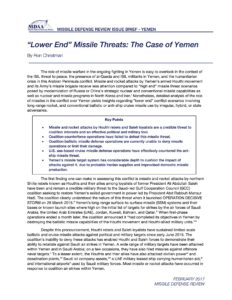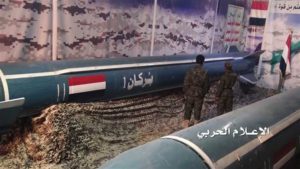ABSTRACT
The role of missile warfare in the ongoing fighting in Yemen is easy to overlook in the context of the ISIL threat to peace, the presence of al-Qaeda and ISIL militants in Yemen, the humanitarian crisis in this Arabian Peninsula conflict, and “high end” missile threats. Detailed analysis of the role of missiles in the conflict over Yemen yields findings and implications regarding “lower end” conflict scenarios involving long-range rocket, and conventional ballistic or anti-ship cruise missile use by irregular, hybrid, or state adversaries.
FINDINGS
Missile and rocket attacks by Houthi rebels and Saleh loyalists are a credible threat to coalition interest and an effective political and military tool. Coalition counterforce operations have failed to defeat this missile threat. Coalition ballistic missile defense operations are also currently unable to deny missile operations or limit their damage. In contrast, U.S. sea-based cruise missile defense operations have effectively countered the anti-ship missile threat. Nonetheless, Yemen’s missile target system has considerable depth to cushion the impact of attacks against it, due to probable Iranian supplies and improvised domestic missile production.
IMPLICATIONS FOR DEFENSE PLANNING
Develop tailored strategies for countering lower-end missile threats rather than considering them lesser included cases in planning and resourcing robust missile defense systems. These strategies should counter likely adversaries’ efforts to protract war via limited missile or rocket attacks vice massed attacks and by maintaining target system depth. Counter strategies supplementing foundational missile defense force structure and new electronic warfare or information operations capabilities should include:
- Attacks on missile industrial infrastructure and support systems
- Interdiction operations against foreign missile transshipment and assistance
- Pre-launch operations to find, fix, track, and attack out-of-garrison missile units
- Offense-defense weapons employment guidance for weapons systems capable of defensive interceptor and offensive strike operations, such as the SM-6 missiles.

Click here to download the complete “Lower End” Missile Threats: The Case of Yemen report. This report originally appeared on the Missile Defense Review, MDAA’s online journal.
By Ron Christman, 2 February 2017
Information Cut Off Date: 2 February 2017
Ron Christman is a Senior Intelligence Officer at the Defense Intelligence Agency. He has 29 years of experience supporting defense planning, military plans, and operations. He was responsible for directing research on all land-based offensive missile forces worldwide for ten years. He served as the Deputy Director of the Regional Command West’s Fusion Center at Camp Arena, Herat, Afghanistan in 2013. The viewpoints and opinions expressed in this article reflect solely the author’s personal views and opinions and do not represent the views of the Defense Intelligence Agency, the Department of Defense, or any other U.S. government agency.

